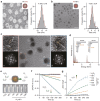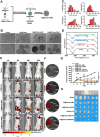Targeted Nanoparticle-Based Therapies for Nasopharyngeal Carcinoma: Enhancing Radiosensitization, Photothermal Therapy, and Diagnostics
- PMID: 40470111
- PMCID: PMC12134383
- DOI: 10.2147/IJN.S523213
Targeted Nanoparticle-Based Therapies for Nasopharyngeal Carcinoma: Enhancing Radiosensitization, Photothermal Therapy, and Diagnostics
Abstract
Nasopharyngeal carcinoma (NPC) remains a major clinical challenge due to its high resistance to conventional therapies such as chemotherapy and radiotherapy. Nanoparticle (NP)-based technologies have emerged as promising tools to enhance the efficacy of NPC treatment through mechanisms like radiosensitization and photothermal therapy. This review discusses the potential of NPs, particularly metal-based nanoparticles (gold and iron oxide), in improving the therapeutic outcomes of radiotherapy by overcoming tumor hypoxia and increasing radiation absorption. Additionally, we explore the application of NPs in photothermal therapy, wherein nanoparticles absorb light and generate localized heat to target tumor cells with precision. NPs are also playing an increasingly vital role in early diagnosis and real-time imaging, enabling more effective monitoring and personalized treatment. Despite the promising potential, challenges as nanoparticle biocompatibility, toxicity, and efficient targeting remain obstacles for clinical translation. In this review, we aim to provide a comprehensive summary of the current state of targeted nanoparticle-based interventions in NPC therapy and to outline the potential for these technologies to improve therapeutic outcomes.
Keywords: nanomedicine; nanoparticle; nanotechnology; nasopharyngeal carcinoma; treatment.
© 2025 Wang et al.
Conflict of interest statement
The authors report no conflicts of interest in this work.
Figures




References
Publication types
MeSH terms
Substances
LinkOut - more resources
Full Text Sources
Miscellaneous

